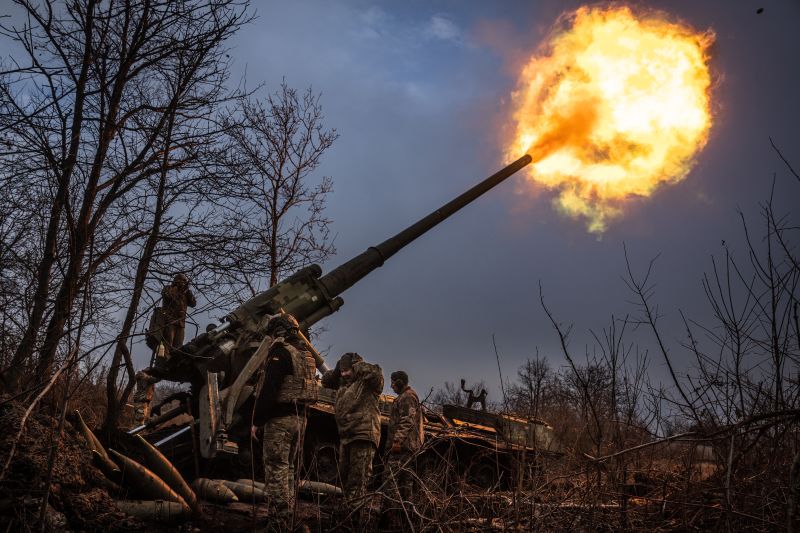
‘There is no future’: Even a potential ceasefire sparks little hope in eastern Ukraine
Could a ceasefire deal be a disaster for Ukraine in disguise?
That is the urgent question echoing in Ukrainian frontline bunkers and in the ruins of besieged towns, where ubiquitous exhaustion begs for peace, but where a costly learned distrust of Russia rules.
Anxiety is manifold. Would a ceasefire hold? Would Russia just use it to re-equip and attack again? Would Moscow even want it, given it is fast winning ground? Would Ukraine’s allies give it the same military support, if they felt diplomacy had led the guns to fall silent?
The screens before Volodymyr Sablyn, a battalion commander in the 66th mechanized brigade, tell a gut-wrenching story of Ukraine’s modern, yet archaically brutal battlefield. Tiny, cheap drones fly over the pockmarked and battered trenches around Lyman – a mix of frozen sludge, trash, bunkers and “beetroot,” the ugly term for human remains that cannot be retrieved.
Sablyn joined the army in February 2015, when Russian separatists took the Donetsk town of Debaltseve despite agreeing to a truce. Now, across the eastern front, ceasefires called a decade ago that provided little but cover for further Russian military advances are living proof of the urgent need for caution at the negotiating table.
The scene Sablyn commands is one where relentless Russian assaults and tolerance of casualties has exploited Kyiv’s key weakness: a lack of infantry. As Sablyn’s forces drop mortars on Lyman’s frontlines, Moscow’s forces are advancing on a vital military hub to his south – Pokrovsk. The pace of its encirclement is startling and, once it falls, Russia will have few major settlements between its forces and the major cities of Dnipro and Zaporizhzhia.
Hope is a key currency here, and one facet of it, consistently raised by Ukrainian officials, is the idea of European or NATO troops providing security guarantees to Kyiv through their specific presence in frontline areas – as peacekeepers of sorts.
“If NATO could send troops to Ukraine,” said Sablyn, “it would be a guarantee of security in Ukraine. Because Russia – no matter how much they say that they are not afraid of anyone – are afraid of America, are afraid of NATO as a whole.”
Yet as dusk settles near the 66th’s forward artillery units, the idea seems beset with insurmountable risk. The threat of Russian drones is so acute, artillery units can be reached when the sun tips into the horizon, and the light is vanishing.
A unit commander who escorts us checks his handheld monitor to see if the Russian surveillance drones have left. We pause for 10 minutes until the all-clear is given and then race across the rocky fields to a tree-line where aging artillery guns deal regular “suppressing fire” to the Russians.
Peace is something here you better be deadly serious about, and the men who live underground are skeptical about.
“There is only a 30% chance of a ceasefire,” said one soldier, Viktor. “Because the situation on the front is not in such a way that we can see that there will be a truce. It’s all very difficult.”
Another, Andriy, added: “I think it’s 40%. The other side is winning, taking territories. And we, by and large, have nothing to say.”
The growing candor of troops who would months ago repeat only studied assurances of victory is replicated by some exhausted civilians from frontline towns.
Slowly trudging through the ravaged streets of Lyman is Larissa, 72, her gold incisors bright among the shell-peppered concrete.
She becomes tearful when asked why she has not left a town first taken in the Russian invasion of 2022, then liberated by Ukrainian forces later that year, and now heavily pressured by Putin’s men again, who are about 10 kilometres (6.2 miles) from its outskirts.
“Here, I ran barefoot; there, I swam in the river,” she said, gesturing to the town’s edges. I am 72, I don’t want to (leave). All my three brothers are buried here, all my aunts, uncles, dad, mum. I can’t leave.”
She has scant sympathy for Kyiv, describing the Ukrainian soldiers she meets in supermarkets as unkempt, and saying a friend’s family of seven left Lyman two weeks earlier and were housed in a stable in nearby Poltava. “A stable! But it was clean and there was some hay.”
Larissa said Trump will be no different to Biden, who she had heard on television tried to buy parts of eastern Ukraine for his son, likely echoing false Russian propaganda. Her hopes are with the Kremlin as the decision-makers.
“Nobody’s going to solve this. Only Putin will if he says, ‘that’s enough, I’ve already killed so many people.’” She nods when asked if peace through Putin is the only path ahead.
Behind her, a bus collects locals who still shuffle in and out of the desolate town to go shopping. None will talk except the driver, Dima, who says he went to Russia when the Russians first invaded to stay with relatives and recently came back. He says he is used to the destruction and hopeful for peace. “It’s all politics. Nothing depends on us. As it is decided, so it will be.”
For others, there has been a decade of turmoil and loss.
Inesa, 60, sits alone in the central square of Slovyansk, where 10 years ago Russian proxy separatists seized the local administration building and fought off the Ukrainian army, over repeated ceasefires, deals and Russian advances.
She said a decade earlier, despite the chaos of separatism, they still had jobs and hope. Now she and her mother are all that remains in Slovyansk, a key Russian target in Donetsk, the rest of her family scattered, she said, across the world by war.
“Now there is no future,” she said. “We don’t see it. Who does? I want it just to stop. Stop the bombing.”
